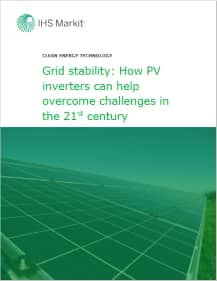Whitepaper: Grid stability - How PV inverters can help overcome challenges in the 21st century
As the world moves towards decarbonization, sources of renewable power such as solar will play a crucial role in new energy generation. Energy generation is gradually shifting from conventional fuels such as coal, oil and natural gas, while demand for electricity is growing rapidly. The electrification of the economy is a major global trend underlying the need for stable, reliable electrical grids. This whitepaper outlines the various challenges for maintaining grid stability in an era of increasing installations of renewable sources such as solar, and the role that technology companies play in ensuring a stable and resilient electrical grid.
Key takeaways:
- A global push to lower carbon emissions is rapidly increasing demand for electricity sourced from renewables. A stable electrical grid is required to support the growing generation and demand for electricity.
- Electrical grid operators are faced with two main challenges. The first challenge is the stable operation and functioning of the grid. The second is the careful balance of supply and demand of electricity.
- Technology companies such as PV inverter suppliers must develop next-generation products to address these challenges. Reactive power, dynamic transient behavior, advanced communications, and Artificial Intelligence (AI) are examples of features that enable PV inverters to help stabilize electrical grids.
- Energy storage is the key to unlock the full value of solar and is an important tool which grid operators can use to balance electricity supply and demand. Batteries in particular have stepped up to this challenge due to the wide range of services these systems can provide for the electrical grid.
Download the full whitepaper to understand the critical role solar energy technology could play in the energy transtion to a low carbon future:
This article was published by S&P Global Commodity Insights and not by S&P Global Ratings, which is a separately managed division of S&P Global.



